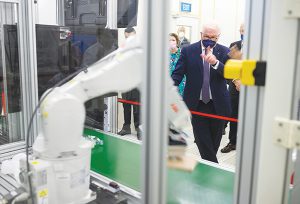If 2021 was the breakthrough year for mRNA vaccines, then 2022 may be the breakthrough year for artificial intelligence. So far there have been major advances in text generation and image generation, and now investor Nat Friedman is predicting big developments in AI personal voice assistants. More innovation will surely follow.
With so much in the works, it is worth reviewing some basic principles of how AI is likely to affect the US and global economies.
First, more AI does not necessarily mean fewer jobs. Automation and mechanisation have been around for centuries, and they create jobs as well as take them away. The job created may be direct, as in robotics production and the surrounding infrastructure, or indirect, as when AI-supported animation is sold and marketed.
Prior to the pandemic, both Japan and the US had full employment and decent living standards. Both were also two of the most mechanised societies in the world and had plenty of robots.
Nonetheless, AI may bring big changes in compensation. Software can already write simple news articles, especially for standardised events such as earnings reports or sports scores. The wages of journalists will fall accordingly, while those of specialists who work on AI will rise.
But the benefits of AI do not accrue only to those in the technology sector. AI makes many goods and services cheaper, and that in turn benefits the poor and disadvantaged. If software routes packages and shipments more efficiently, then transportation costs will be lower. If software and AI programs help economise on the use of electricity, then it will be easier to mitigate climate change. As computational biology improves health care, the sick will benefit.
The people who least need AI are the super-rich. They already can hire armies of servants to manage their obligations, schedules, and so on. They do not need to economise on the use of human labour. The rest of us do, whether directly or indirectly through the businesses we patronise.
Another benefit for lower-income groups is that current manifestations of AI do not usually displace the jobs of the poor. Many poor individuals hold jobs in the service sector or perform manual labour. Those tasks are either hard to automate (a robot gardener?) or, because wages are low, less profitable to automate. It may be true that the costs of AI in the labour force — displaced jobs — are more visible than the benefits of AI — new jobs and lower prices. So it’s not surprising if AI is not entirely popular.
—Bloomberg
 The Gulf Time Newspaper One of the finest business newspapers in the UAE brought to you by our professional writers and editors.
The Gulf Time Newspaper One of the finest business newspapers in the UAE brought to you by our professional writers and editors.
